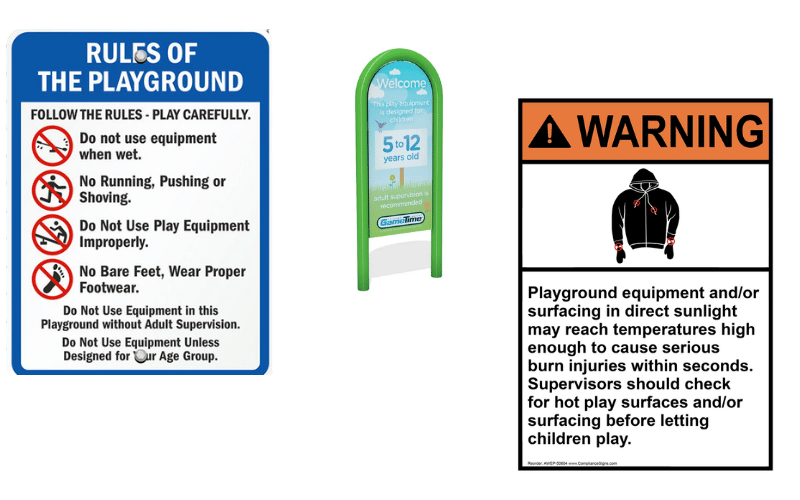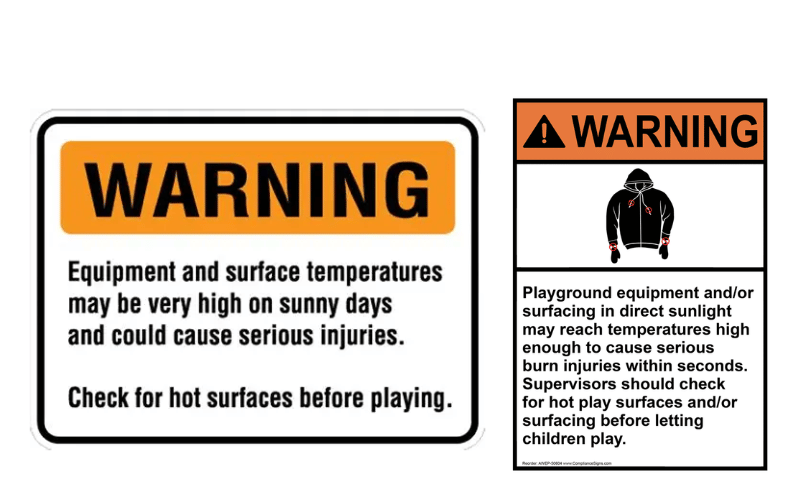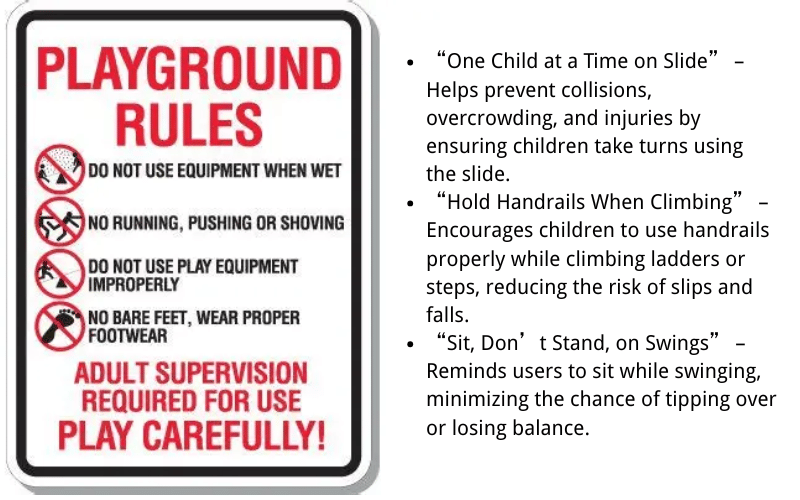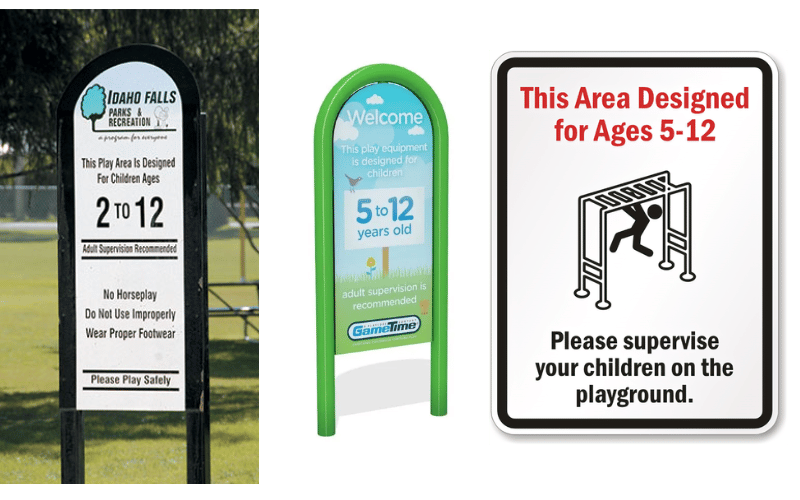Did you know that nearly 200,000 children visit emergency rooms each year due to playground-related injuries? While it’s easy to focus on bright slides and climbing walls, one often overlooked but critical feature of any playground is its signage. Playground equipment signs play a vital role in keeping children safe, ensuring parents are informed, and creating an environment that’s both fun and secure.
This blog will uncover why these signs are more than just a minor detail. We’ll examine their importance, explore the various types designed to suit different needs, and highlight the numerous benefits they bring to playgrounds. Whether you’re a parent, teacher, or community planner, understanding playground equipment signs can make a difference in promoting safety and accessibility.
Stay tuned as we take a closer look at this essential yet often underrated part of playground design!
Table of Contents
ToggleWhy Playground Equipment Signs Matter?
Ensuring Safety for Children and Adults
Playground equipment signs are a cornerstone of safety in recreational spaces. They serve as a visual guide for both children and adults, offering clear instructions on how to use the equipment properly. For instance, a sign might explain the correct way to climb a structure, use a slide, or swing safely. This guidance minimizes the risk of accidents caused by improper use, including falls and collisions. Additionally, these signs often include reminders for adult supervision, ensuring that caregivers remain vigilant while children play. By providing this essential information, playground signs create a safer environment where everyone can enjoy themselves without unnecessary risks.
Providing Age-Appropriate Guidelines and Hazard Warnings
Another critical function of playground signs is to establish age-appropriate guidelines. Not all equipment is suitable for every age group, and signs help differentiate which structures are designed for toddlers, older children, or even adults. For example, a climbing wall meant for teenagers might be too challenging or dangerous for a preschooler. By clearly marking age recommendations, these signs prevent younger children from attempting activities that could lead to injury. Furthermore, playground signs often include warnings about potential hazards, such as wet surfaces, sharp edges, or weight limits. These warnings empower users to make informed decisions and take necessary precautions, reducing the likelihood of accidents.
Promoting Inclusivity with Accessible Equipment
Inclusivity is a vital aspect of modern playground design, and signage plays a key role in promoting it. Accessible playground equipment, such as wheelchair-friendly swings or sensory play areas, is often marked with signs to indicate its purpose and usage. These signs ensure that children and adults with disabilities can easily identify equipment designed for their needs, fostering a sense of inclusion and belonging. Additionally, inclusive signage may provide instructions in multiple languages or use universally recognized symbols, making the playground more welcoming to diverse communities. By prioritizing accessibility, playground signs help create an environment where everyone, regardless of ability, can participate and enjoy the space.
In conclusion, playground equipment signs are more than just informational tools—they are essential for ensuring safety, providing guidance, and promoting inclusivity. By addressing the needs of all users, these signs contribute to a safer, more enjoyable, and welcoming playground experience for everyone.
Types of Playground Equipment Signs
1. Warning Signs
Warning signs are essential for ensuring safety on playgrounds, as they alert users to potential hazards and help prevent accidents. These signs are designed to be highly visible, often featuring bright colors, bold fonts, and universally recognized symbols to grab attention and communicate risks quickly. Here are some common examples of warning signs and their purposes:
- “Adult Supervision Required” reminds caregivers that children should not use playground equipment without adult oversight, reducing the risk of injuries caused by unsupervised play.
- “No Climbing on Outside of Structure” Discourages unsafe behavior, such as climbing on railings, roofs, or other non-designated climbing areas, which could lead to falls or injuries.
- “Caution: Hot Surface in Summer” Warns users about equipment like metal slides or swings that can become dangerously hot under direct sunlight, helping to prevent burns.
Warning signs are typically made from durable, weather-resistant materials such as aluminum or high-density polyethylene (HDPE) to ensure longevity and effectiveness. These materials are designed to withstand harsh outdoor conditions, including rain, UV exposure, and temperature fluctuations, ensuring the signs remain legible and functional over time.
2. Instructional Signs
Instructional signs are designed to educate and guide children on the safe and proper use of playground equipment. Unlike warning signs, which focus on hazards, instructional signs provide clear, step-by-step directions or visual diagrams to promote safe behavior. These signs are vital for reducing misuse and preventing accidents. Here are some common examples and their purposes:
- “One Child at a Time on Slide” – Helps prevent collisions, overcrowding, and injuries by ensuring children take turns using the slide.
- “Hold Handrails When Climbing” – Encourages children to use handrails properly while climbing ladders or steps, reducing the risk of slips and falls.
- “Sit, Don’t Stand, on Swings” – Reminds users to sit while swinging, minimizing the chance of tipping over or losing balance.
Instructional signs are especially critical for more complex equipment, such as rope climbers, zip lines, or merry-go-rounds, where improper use can lead to serious injuries. By providing clear and easy-to-follow guidance, these signs help children and their caregivers use the playground safely and confidently.
3. Age-Appropriate Signs
Age-appropriate signs are crucial for ensuring that children use playground equipment designed for their developmental stage. Not all equipment is safe or suitable for every age group, and these signs help parents and children quickly identify which structures are suitable for their age. By clearly marking age recommendations, these signs reduce the risk of injuries caused by younger children attempting equipment that is too advanced or older children using equipment that is too small for their age. Here are typical examples and their purposes:
- “For Ages 2-5 Only” – Indicates equipment designed for toddlers and preschoolers, featuring smaller steps, lower platforms, and less complex features to accommodate their size and abilities.
- “Recommended for Ages 5-12” – Refers to taller, more challenging structures with features like climbing walls, monkey bars, or higher slides, which are better suited for school-age children with greater strength and coordination.
These signs are typically placed near the entrance of specific play zones or directly on the equipment to ensure they are easily visible. By guiding children to age-appropriate areas, these signs help create a safer and more enjoyable play environment for everyone.
4. Maintenance and Inspection Signs
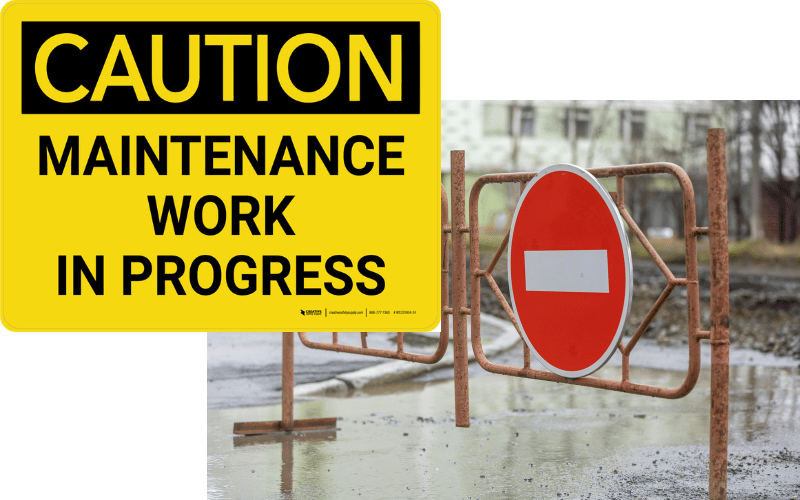
Maintenance and inspection signs play a vital role in ensuring playground safety by informing both facility managers and the public about the upkeep of the equipment. While primarily intended for staff, these signs also reassure parents and caregivers that the playground is regularly monitored and maintained to meet safety standards. Here are typical examples and their purposes:
- “Inspected Monthly” – Communicates that the playground undergoes routine safety checks, giving parents confidence that the equipment is in good condition and safe for use.
- “Report Damaged Equipment” – Encourages community involvement by providing clear instructions and contact information for reporting broken or unsafe equipment, ensuring timely repairs and reducing risks.
These signs are typically placed near playground entrances or in visible areas to ensure they are easily noticed. In addition to promoting safety, maintenance signs are crucial for liability protection, as they demonstrate that the playground is actively managed and that safety is a priority. By fostering transparency and community engagement, these signs contribute to a safer and more reliable play environment.
5. Inclusive Play Signs
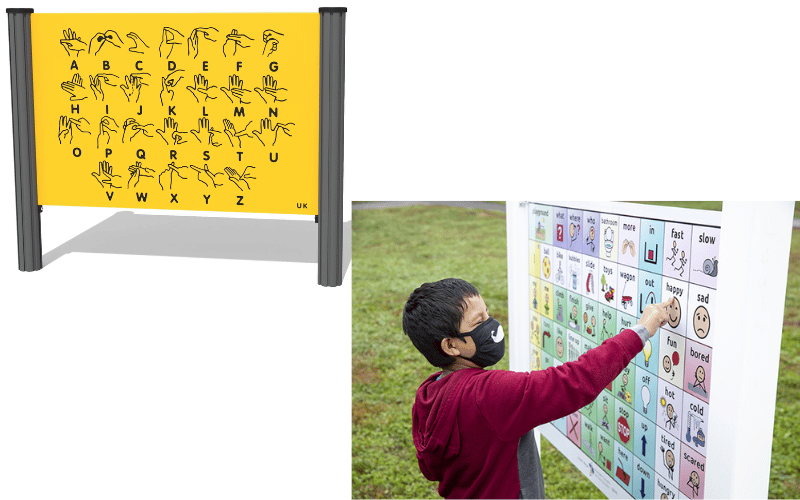
Inclusive play signs are essential for modern playgrounds, as they emphasize accessibility and ensure that children of all abilities can enjoy the space. These signs highlight equipment specifically designed for children with disabilities, making it easier for caregivers to identify suitable play options for their children. By promoting inclusivity, these signs create a welcoming environment for everyone. Here are some common examples and their purposes:
- “Wheelchair-Accessible Swing” identifies adaptive swings equipped with harnesses or platforms, which allow children who use wheelchairs to safely enjoy the experience of swinging.
- “Sensory Play Panel” – Highlights features like tactile surfaces, spinning elements, or auditory components designed for children with sensory processing needs, providing engaging and calming play opportunities.
Inclusive play signs are often placed near the equipment or at the entrance of accessible play areas to ensure they are easily located. These signs not only guide caregivers but also foster a sense of community by demonstrating that the playground is designed to accommodate a diverse range of needs. By making play areas more inclusive, these signs help ensure that every child can participate and have fun.
Designing Effective Playground Signs
Clear Language
The foundation of an effective playground sign is the use of clear and concise language. Messages should be straightforward, avoiding technical jargon or overly complex sentences. For example, instead of saying, “This apparatus is intended for individuals aged 5 to 12 years,” a simpler version, such as “For ages 5-12 only,” is more effective. Clear language ensures that both children and adults can quickly understand the information, reducing confusion and promoting safe behavior. Additionally, using action-oriented phrases like “Hold the rail while climbing” or “Do not stand on the slide” provides direct guidance on proper usage.
Bold Fonts and Bright Colors
The visual design of a playground sign is just as important as its content. Bold, easy-to-read fonts ensure that the text is legible from a distance, even in busy or crowded environments. Bright colors, such as red, yellow, or blue, help the sign stand out and grab attention. For instance, a warning sign might use a red background to signal caution, while an instructional sign could use a bright yellow to indicate essential guidelines. The combination of bold fonts and vibrant colors ensures that the sign is both noticeable and easy to read, even for young children or individuals with visual impairments.
Universal Symbols
Incorporating universal symbols is crucial for making playground signs accessible to a diverse range of audiences. Symbols, such as a wheelchair icon for accessible equipment or a stick figure sliding down a slide, convey information quickly and effectively without relying solely on text. These symbols are beneficial for young children who may not yet be able to read or for visitors who speak different languages. By using universally recognized imagery, playground signs can communicate essential messages to everyone, regardless of age, language, or literacy level.
Durability and Weather-Resistant Materials
Playground signs must be designed to withstand the elements, as they are exposed to various weather conditions throughout the year. Using durable, weather-resistant materials such as aluminum, high-density polyethylene, or UV-coated plastics ensures that the signs remain intact and legible over time. These materials resist fading, rust, and damage from rain, snow, or intense sunlight. Durable signs not only maintain their appearance but also continue to provide critical safety and instructional information without frequent replacements, making them a cost-effective solution for playground management.
Strategic Placement
The placement of playground signs is another key factor in their effectiveness. Signs should be positioned in prominent locations, such as near the playground entrance or directly adjacent to specific equipment. They should also be placed at eye level for both adults and children, ensuring that the information is easily accessible to all users. For example, a sign warning about weight limits on a swing set should be placed directly on or near the swing frame, where it is impossible to miss. Proper placement ensures that the signs serve their purpose and are noticed by those who need the information most.
In conclusion, designing effective playground signs requires attention to both content and presentation. By using clear language, bold fonts, bright colors, universal symbols, durable materials, and strategic placement, playground signs can effectively communicate important messages, enhance safety, and create an inclusive environment for all visitors.
Regulations and Standards
Safety Standards and Guidelines
Playground equipment signs are often designed by established safety standards and guidelines to ensure they meet specific requirements. For example, the American Society for Testing and Materials (ASTM) provides detailed standards, such as ASTM F1487, which outlines safety specifications for playground equipment. Similarly, the Americans with Disabilities Act (ADA) sets guidelines to ensure playgrounds are accessible to individuals with disabilities. These regulations cover various aspects, including the design, placement, and content of playground signs, ensuring they effectively communicate safety information and promote inclusivity. By adhering to these standards, playground operators can create environments that are both safe and welcoming for all users.
Ensuring Consistency and Safety
Regulations and standards play a critical role in maintaining consistency and safety across playgrounds. When signs follow established guidelines, they provide uniformity in how information is presented, making it easier for users to understand and trust the messages. For instance, a parent visiting different playgrounds can expect to see similar warnings about age restrictions or weight limits, which reduces confusion and enhances safety. Additionally, compliance with standards ensures that signs effectively address potential hazards, thereby minimizing the risk of accidents. By standardizing the design and content of playground signs, these regulations help create safer and more reliable recreational spaces for children and adults alike.
Benefits of Playground Equipment Signs
Improved Safety and Reduced Accidents
One of the most significant benefits of playground equipment signs is their ability to enhance safety and reduce the incidence of accidents. By providing clear warnings about potential hazards, such as weight limits, age restrictions, or slippery surfaces, these signs help users make informed decisions and avoid risky behavior. For example, a sign indicating that a climbing structure is suitable for children aged 5 to 12 prevents younger children from attempting to use equipment that may be unsafe for them. Additionally, safety signs remind caregivers to supervise children, further reducing the likelihood of injuries. By proactively addressing safety concerns, playground signs create a more secure environment for everyone.
Enhanced User Experience Through Clarity and Guidance
Playground equipment signs also enhance the overall user experience by offering clarity and guidance. Instructional signs, for instance, provide step-by-step directions on how to use specific equipment, ensuring that users can confidently and without confusion enjoy the playground. Informational signs, such as those displaying park rules or hours of operation, help visitors understand the expectations and make the most of their time at the playground. When users have access to clear and helpful information, they are more likely to feel comfortable and engaged, leading to a more enjoyable experience for both children and adults.
Encouraging Responsible Use and Fostering Community
Another key benefit of playground equipment signs is their role in encouraging responsible use of the facilities. By outlining proper behavior, such as “Take turns on the slide” or “No rough play,” these signs promote a sense of respect and cooperation among users. This not only helps prevent conflicts but also fosters a sense of community, as visitors are encouraged to share the space in a harmonious manner. Inclusive signs that highlight accessible equipment further contribute to this sense of community by ensuring that everyone, regardless of ability, feels welcome and valued. In this way, playground signs not only protect users but also create a positive and inclusive atmosphere.
In summary, playground equipment signs offer numerous benefits, including improved safety, reduced accidents, enhanced user experience, and a sense of community. By providing essential information and promoting responsible behavior, these signs play a vital role in creating safe, enjoyable, and inclusive playground environments.
Real-Life Examples
Examples of Well-Designed Playground Signs
Well-designed playground signs can be found in many parks and recreational areas, serving as excellent examples of how effective signage enhances safety and user experience. For instance, a playground in Central Park, New York City, features signs with bold fonts, bright colors, and universal symbols. These signs indicate age-appropriate zones, such as areas for toddlers versus older children, and provide simple instructions for using equipment like swings and slides. The inclusion of multilingual text ensures that the diverse community of visitors can easily understand the information. These signs have been praised for their clarity and accessibility, contributing to a safer and more inclusive environment.
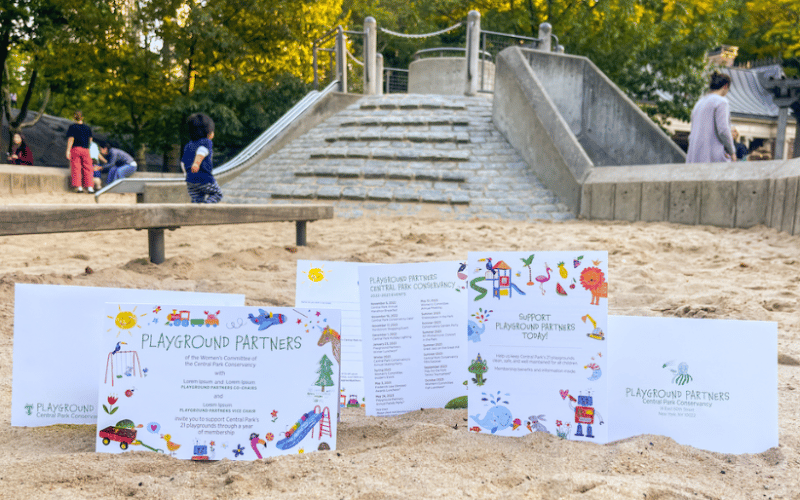
Another example is the signage at Morgan’s Wonderland playground in San Antonio, Texas, a park specifically designed for children with and without disabilities. The signs here highlight accessible equipment, such as wheelchair-friendly swings and sensory play areas, using universally recognized symbols and easy-to-read text. These signs not only guide users but also promote inclusivity by ensuring that children of all abilities feel welcome and supported.
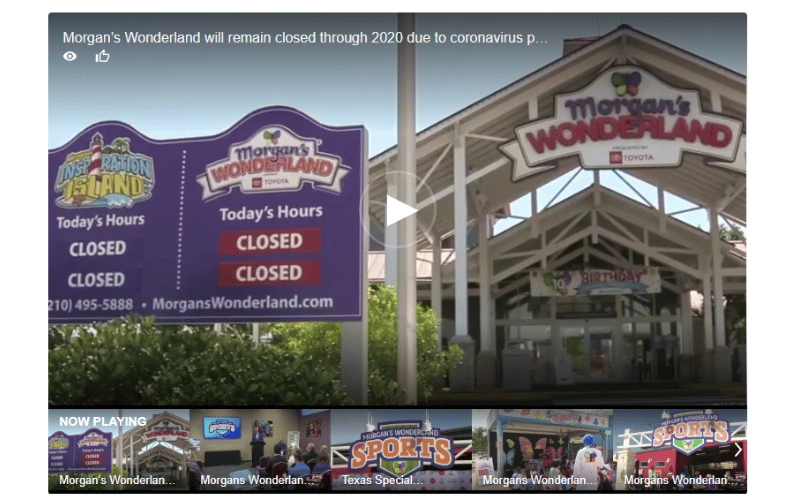
Case Study: A Success Story in Playground Safety
A notable success story comes from a community park in Seattle, Washington, where the implementation of new playground signs significantly reduced accidents and improved user satisfaction. Before the signs were installed, the park experienced frequent injuries due to improper use of equipment, such as children climbing on structures not designed for their age group. After consulting with safety experts, the park introduced signs that clearly outlined age restrictions, weight limits, and proper usage instructions. The signs were strategically placed at eye level near each piece of equipment and designed with bright colors and bold fonts for maximum visibility.
Within six months of installing the signs, the park reported a 40% decrease in playground-related injuries. Parents and caregivers also expressed greater confidence in allowing their children to play, knowing that the signs provided clear guidance. The success of this initiative highlights the critical role that well-designed playground signs play in creating safer and more enjoyable recreational spaces.
In conclusion, real-life examples and success stories demonstrate the tangible impact of adequate playground signage. From reducing accidents to fostering inclusivity, these signs are a vital component of any well-maintained playground, ensuring that all visitors can enjoy the space safely and confidently.
Frequently Asked Questions
Q: What are playground equipment signs?
A: Playground equipment signs are instructional and safety-focused signs placed in parks and recreational areas. They communicate essential information, such as safety rules, age-appropriate guidelines, and proper equipment usage, ensuring that children and adults can enjoy the playground safely.
Q: Why are playground safety signs vital?
A: Playground safety signs are vital for preventing injuries by providing clear instructions and warnings about safe play practices. They guide parents, caregivers, and children on the use of age-appropriate equipment and safety rules, creating a secure and enjoyable outdoor environment for everyone.
Q: What types of information can be found on playground signs?
A: Playground signs typically include safety rules, age recommendations for equipment, warnings about potential hazards, and instructions for proper use. Some signs also welcome visitors, outline park rules, and provide emergency contact information to ensure a safe and well-organized play area.
Q: How can custom signs enhance playground safety?
A: Custom signs can be designed to match specific playground themes or address unique safety needs. By incorporating engaging visuals, storytelling elements, or themed designs, custom signs capture attention while effectively communicating safety rules, making the playground both fun and safe for children and parents.
Q: What materials are used for durable playground equipment signs?
A: Durable playground equipment signs are made from weather-resistant materials like high-density polyethylene, aluminum, or composite materials. These materials withstand outdoor elements such as rain, sun, and snow, ensuring the signs remain legible and practical over time.
Q: How do playground signs promote a safe play environment?
A: Playground signs promote safety by clearly displaying rules, age recommendations, and hazard warnings. They guide children on the proper use of equipment and alert parents to potential risks, thereby reducing the likelihood of accidents and fostering a secure play environment.
Q: What role do ANSI and ASTM standards play in playground signage?
A: ANSI (American National Standards Institute) and ASTM (American Society for Testing and Materials) standards provide essential guidelines for the design, content, and placement of playground signs. Compliance with these standards ensures that the signs effectively communicate safety information and meet industry regulations.
Q: How can parents ensure their kids are safe while playing?
A: Parents can keep their kids safe by reading and following playground safety signs, supervising their children during play, and encouraging them to use age-appropriate equipment. Teaching children to follow the rules outlined on the signs helps minimize risks and ensures a fun, injury-free experience.
The Bottom Line
Playground equipment signs are more than just notices—they are vital tools for preventing injuries and providing guidance to users. From warning signs to accessibility indicators, each type serves a unique role in creating a safe and enjoyable play environment.
When designing or maintaining a playground, selecting the proper signage ensures compliance with safety standards and enhances the overall experience. Whether for a school, park, or community center, well-placed, durable signs help keep children protected while they play.
By prioritizing clear and effective signage, we can make playgrounds safer and more welcoming for all children.




